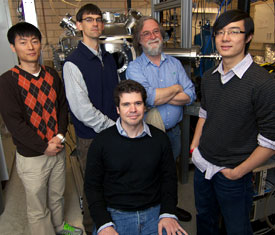Nov 10 2010
The fastest movies ever made of electron motion, created by scattering x-rays off of graphene, have shown that the interaction among its electrons is surprisingly weak.
Graphene is a single atomic layer of carbon whose unusual electronic structure makes it a candidate for a new generation of low-cost, flexible electronics. A major outstanding question is whether the electrons in graphene move independently, or if their motion is correlated by Coulomb repulsion.
 (l to r) Young Il Joe, Peter Abbamonte, Eduardo Fradkin,
Yu Gan; (seated) Bruno Uchoa. Photo by Hsin-Mao Wu.
(l to r) Young Il Joe, Peter Abbamonte, Eduardo Fradkin,
Yu Gan; (seated) Bruno Uchoa. Photo by Hsin-Mao Wu.
Using advanced x-ray scattering techniques, physicists in Peter Abbamonte’s group at the University of Illinois at Urbana-Champaign have imaged the motion of electrons in graphene with resolutions of 0.533 Å and 10.3 attoseconds. Their results were published on November 5 in Science.
Exactly how small and how fast are these measurements? An angstrom is 1/10,000,000,000 of a meter, about the width of a hydrogen atom. And an attosecond is to a second as a second is to the age of the universe.
The researchers found that graphene screens Coulomb interactions surprisingly effectively, causing it to act like a simple, independent-electron semimetal. Their work explains several mysteries, including why freestanding graphene fails to become an insulator as predicted. The study also demonstrates a new approach to studying ultrafast dynamics, creating a new window on the most fundamental properties of materials.
The experiments were carried out at the Frederick Seitz Materials Research Laboratory at the University of Illinois and the Advanced Photon Source at Argonne National Laboratory.
This work was supported by the U.S. Department of Energy under grants DE-FG02-07ER46459 and DE-FG02-07ER46453 through the Frederick Seitz Materials Research Laboratory, with use of the Advanced Photon Source supported by DEAC02- 06CH11357. The conclusions presented are those of the researchers and do not necessarily reflect the views of the U.S. Department of Energy.